Obama Hugs Ensign McCain
I stumbled on these at Daylife whilst looking for a photo to illustrate my “Obama Foreign Policy: Bush 2.0?” post:
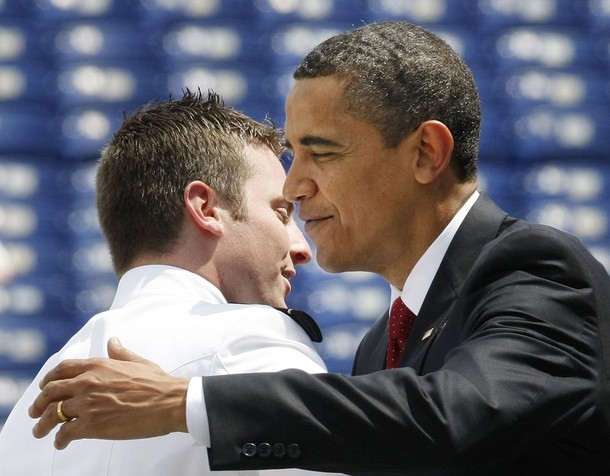
U.S. President Barack Obama (R) hugs graduate John S. McCain IV (L), son of U.S. Sen. John McCain, while attending the 2009 U.S. Naval Academy graduation in Annapolis, Maryland, May 22, 2009.
It’s a nice reminder as we head into the Memorial Day weekend that partisan politics is but a small part of life and that the things that unite us are much more important and powerful than those that divide us.
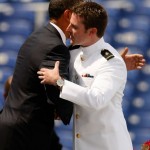
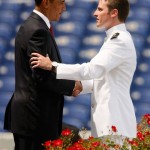
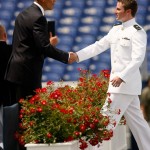



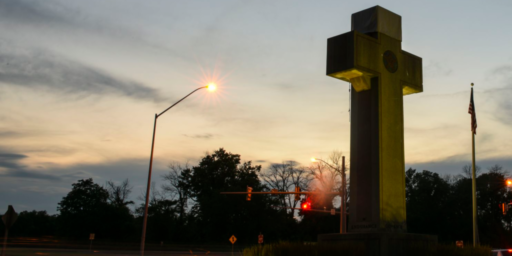
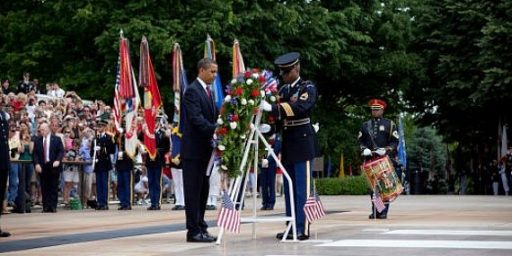

I presume they photo shopped out the “Kick Me!” sign the president slapped on the kid’s back.
Classic Robert Klein routine in 5 . . . 4 . . . 3 . . .
The Times reported it this way:
In his speech, Obama said:
Clad in sparkling summer dress whites, the graduates greeted their new commander in chief with hoots, hollers and raucous applause. Mr. Obama, in return, praised them for the path they had chosen — a notable contrast, he suggested, to the pursuit of wealth that helped foster the current economic crisis.
When all the diplomas had been handed out, the 2009 class president, Ensign Andrew R. Poulin, summoned Mr. Obama back to the podium to present him with a black flight jacket emblazoned on the back with gold block letters that read “commander in chief.â€
“It even has pockets for your Blackberry, and you will look sharp on the basketball court with this, sir,†Ensign Poulin said.
Mr. Obama took off his blue suit coat, slipped on the jacket, and flashed the graduates a thumbs up.
Yes, James, it’s so nice to see partisan politics put aside…
Oh, wait! That wasn’t a caption contest? Umm, … *blush* … Well, it looks like … I mean, the photo is soo Rodney-esque … Er, forget it. Maybe I shoulda had a second cuppa coffee this morning.
Since it’s Memorial Day weekend, and the president spoke at Annapolis, I’d like to direct everyone’s attention to one of the bravest, if not the bravest, feat of arms by US fighting men in World War II: the action of Taffy 3 off Samar Island in the Battle of Leyte Gulf. I mean this with the deepest respect–those sailors, especially LCdr Ernest Evans and the men of the USS Johnston, fought like Marines. You need only bear in mind one fact about the fight: The Japanese battleship Yamoto displaced more than the entire complement of ships composing Taffy 3 (3 destroyers, 4 destroyer escorts, 5 escort carriers; Japanese order of battle: 4 battleships, 6 heavy cruisers, 2 light cruisers, 11 destroyers). Never were so few outgunned by some many.
See, James D. Hornfischer, The Last Stand of the Tincan Sailors for a complete history of the battle.
That’s one hell of a story sam thanks..
re: William d’Inger | May 23, 2009 | 12:57 pm
I guess your obtuse eyes missed the fact that this post has a set of four pictures in it rather than just one…if this were a caption contest, I would expect something else, perhaps along the lines of, “I presume they photo shopped out the knife that the president was sticking in the kid’s back.” That seems more along the lines of what is usually written in those things…
Nice Sam, man, how brave they are.
Whoa! I was thinking in terms of a run-of-the-mill practical joke people play. I consider the president laid back enough to engage in a harmless prank when the situation warrants. I suppose I should have guessed some knee-jerk liberal would turn it into a partisan political rant.
Actually, you did that with your first comments on this thread…
Matt, GA:
Yes, those men can’t be held in high enough esteem. The Johnston in the course of making its one-ship attack on the Japanese fleet (and blowing off the bow of a Japanese cruiser) was, as you might guess, pounded, just pounded, by Japanese gunnery. Evans was able to bring the ship about and was retiring from the fight when he saw that all the other “little guys” (in Adm. Sprague’s words) were now rushing to the attack. So, he brought Johnston about again and headed back into the fray. But Johnston’s luck had run out. Eventually, it was surrounded by Japanese ships and essentially obliterated. But then, as it was sinking, a strange and beautiful thing happened, strange and beautiful for the Pacific war. As Johnston was going to its grave, and the Japanese ships were gliding by it, one of the Japanese commanders had his sailors stand at attention at the rail, and they saluted Johnston as they went by. A grace note in a theater of war where grace notes were unknown.
Well, actually, Japanese would have bowed rather than saluted. It’s really the same thing. The tradition is called “rendering passing honors” (or similar terminology depending on the nationality). I have heard that story before, but I don’t have a reliable source for it. Is that in Morison’s “History”?
IIRC, I read it in The Last Stand of the Tincan Sailors.
I actually saw a vintage newspaper clipping that was about one of the survivors but they also noted the Japanese cruiser..
The part that really got me about the Johnston was that the skipper ended up controlling her from the tail of the ship by yelling down a hatch at people manually moving the rudder. That’s borderline “insane”..
Oh and the newspaper article stated that someone on the cruiser threw a can of peaches to the survivors.
There’s nothing insane about it. Manual rudder control by voice command is standard procedure for loss of electric/hydraulic means. It’s something we practiced as a regular drill. It was no different than fire, flooding or man overboard drills.
It is a great book, and a real page turner. Read it. 2… 3…. maybe 4 times. I have.
And when you get done with that, read “With the Old Breed” by E.B. Sledge… 7 or 8 times.
One more: Lewis Grizzard’s “My Daddy was a Pistol and I’m a Son of a Gun”
Here is Ernest Evans’s Medal of Honor citation, from this magnificient, and humbling, site, Medal of Honor Citations, which lists the citations of Medal of Honor awardees for all conflicts in which the medal has been bestowed.
I consider standing on the fan tail out in the open while being shot at as rather insane but I guess in reality a 14 inch shell doesn’t care if there’s a couple inches of steel between you and it..
By insane I mean like an amazing level of bravery that I couldn’t accomplish myself..
@Sam yeah I thought about posting that when I found it the other day..